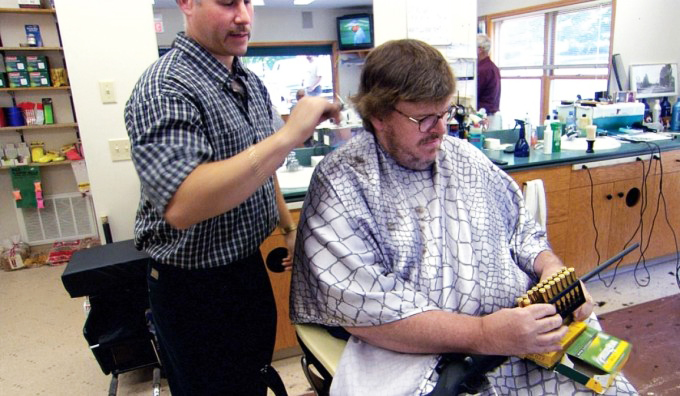Lights, Camera, Political Action: ‘Bowling for Columbine’

The 2002 documentary “Bowling for Columbine” details director Michael Moore’s efforts to investigate the causes of the massacre and the larger issue of gun violence in the U.S. (IFC Films)
By Kevin Truong
Oct. 23, 2015 12:46 a.m.
Flip on a news channel and you’re likely to see characters with perfectly coiffed hair making fantastical claims directly to camera. But how far does this connection between political figures and entertainment go? Each week A&E columnist Kevin Truong will look at a movie through the lens of modern politics, analyzing whether the political climate has changed or remained the same.
On the morning of April 20, 1999, seniors Eric Harris and Dylan Klebold executed a coordinated attack on Columbine High School where they shot and killed 13 people and injured another 23, before taking their own lives.
It remains the deadliest high school shooting in American history and the name Columbine still resonates in the popular consciousness as a byword for mass shootings and school violence.
In the debate surrounding the massacre that followed, commentators paraded out an endless row of explanations that tried to grasp at some reasoning behind the tragedy. Access to guns, bullying, goth culture, Marilyn Manson, antidepressants and violent video games were all pointed to as possible influences of the two gunmens’ actions.
“Bowling for Columbine,” released in 2002, was documentarian Michael Moore’s own effort to dig into the root causes of the massacre and larger issue of gun violence in the United States.
By themselves, the numbers are staggering. Every year, according to the Centers for Disease Control and Prevention, more than 30,000 people die in the U.S. because of gun violence, outstripping all other developed nations.
The film sees Moore using his trademark confrontational interviews with National Rifle Association representatives and anachronistic montages to debunk some of the pet theories behind the violence, like some innate American historical drive toward aggression and the evil pull of heavy metal music.
Instead, Moore points to the culture of fear and racial tension perpetuated by the media, the massive reactionary power of the NRA and a blanket response by the federal government of institutionalized violence toward social and foreign policy issues.
“Bowling for Columbine” also briefly explores the pathology behind America’s obsession with guns – namely, the anti-government paranoia that is inherent to the fabric and formation of the U.S. and its history.
But while the movie brings up good points with a special earnestness and wink to the camera, it still feels sadly familiar.
After every mass shooting, the same perennial questions pop up, the same accusations are thrown out, the same points are made.
What everyone agrees to, in the midst of all the finger-pointing, is the need to stop anything like Columbine from ever happening again.
Sixteen years later, it’s safe to say we’ve failed.
According to FBI statistics, mass shootings have risen drastically since the year 2000. An average of 16.4 such shootings happened annually from 2007 to 2013, compared to 6.4 shootings annually from 2000 to 2006.
School names are associated with victim counts. They read like an anonymous counter ticking upward.
There is a rawness to Moore’s film that comes from it being only three years removed from Columbine and one year away from 9/11. Moore captures the anger, fear and tears of the people caught on camera.
Besides the measured treatment of tragedy though, there is also a fair amount of humor in the documentary. In his once-a-movie signature spectacle, Moore takes two survivors of the shooting in Columbine High School and attempts to return the Kmart bullets that were permanently lodged in them during the shooting.
That little bit to smile about is indicative of something so much more heartbreaking when considered in 2015.
It speaks of hope, the ability to see something change, some positive switch that may pull the country out of a place where tens of thousands of gun-related deaths happen every year. And the U.S. has the most school shootings of any nation on Earth.
When talking about the epidemic proportions of mass shootings nowadays, there is little ironic humor to be found. What there is instead is a ceaseless, nihilistic feeling of resignation that this is the world we are living in, and if we’re being perfectly honest with ourselves, the world we’ll die in.

